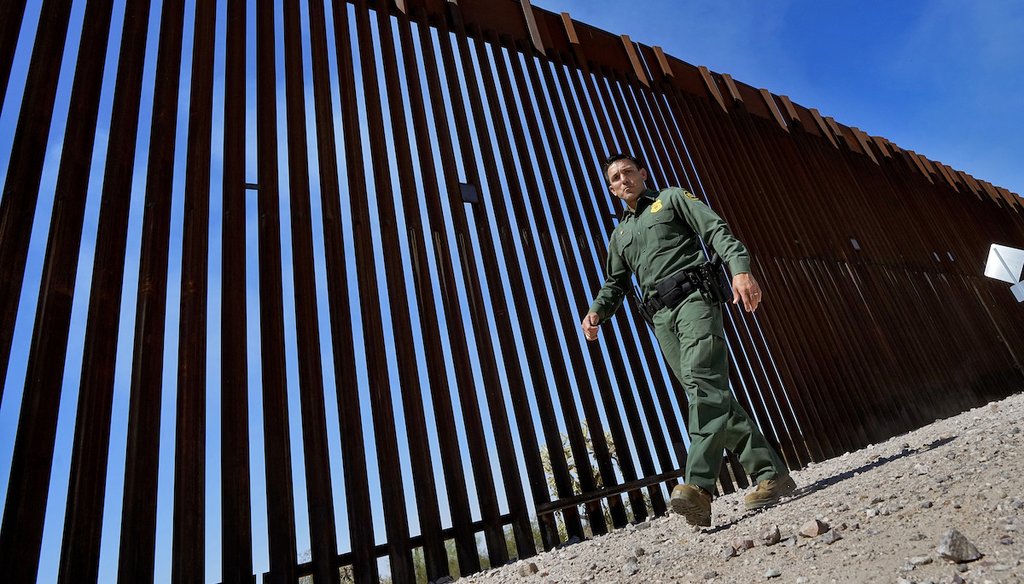Stand up for the facts!
Our only agenda is to publish the truth so you can be an informed participant in democracy.
We need your help.
I would like to contribute

Border Patrol Deputy Chief for the Tucson Sector Justin De La Torre walks along the border fence of the U.S.-Mexico border, on Aug. 29, 2023, in Organ Pipe Cactus National Monument near Lukeville, Ariz. (AP)
If Your Time is short
-
The FBI’s terrorist watchlist is a federal database of people who are either known or suspected terrorists.
-
Immigration officials recorded 736 encounters in fiscal year 2023 (which ended Sept. 30) with people on the watchlist. That doesn’t mean 736 terrorists entered the country.
-
Immigration officials can deny entry to people they encounter who are on the list. If people are allowed in, they are "almost certainly detained" while a judge hears their case, an expert said.
Some Republican lawmakers are flagging Hamas’ attack on Israel as an example of why more security is needed at the southern U.S. border. Hamas militants breached a border fence and attacked Israeli villages bordering the Gaza Strip on Oct. 7.
"Potential terrorists are attempting to cross our southern border. In September alone, 18 illegal immigrants on the terror watchlist were caught at the border," U.S. Sen. Marsha Blackburn, R-Tenn., posted Oct. 21 on X. "The attack on Israel should serve as a warning as to why we must secure the border."
The next day, U.S. Rep. Kevin McCarthy, R-Calif., also mentioned the terrorist watchlist on NBC’s "Meet The Press."
"We just caught 18 people, just last month, on the FBI terrorist watchlist, coming across our border," McCarthy said. "More than 160 have done it this year, a record breaking."
U.S. immigration officials have encountered rising numbers of people on the watchlist. But not everyone on the list is a terrorist, and not everyone encountered is allowed to enter the country.
Sign up for PolitiFact texts
Terrorism and immigration experts say the threat of attacks in the U.S. and Israel are incomparable.
"They both involve borders, but the comparison ends there," David Bier, an immigration expert at the libertarian Cato Institute, previously told us. "People aren’t crossing the border to conduct terrorist attacks or take over parts of the United States. A very small percentage may come to commit ordinary crimes, like selling drugs, but overwhelmingly, they are coming for economic opportunity and freedom."
McCarthy’s office did not respond to our query for more information. A Blackburn spokesperson pointed us to a Fox News reporter’s post on X. Customs and Border Protection did not confirm whether 18 people were stopped in September.
Here’s what we know about who is on the terrorist watchlist, and what the data can and can’t tell us.
The terrorist watchlist, run by the FBI’s Terrorist Screening Center, is a federal database of people who are known or suspected terrorists.
"Known terrorists" include people who have been charged, arrested, indicted or convicted of a terrorism-related crime or who belong to a foreign terrorist organization.
"Suspected terrorists" are people who are "reasonably suspected to be" involved in terrorist activities.
U.S. government agencies nominate people to the terrorist watchlist and those names are vetted by the National Counterterrorism Center or the FBI.
For years, civil liberty groups have cited concerns about the nomination process and its lack of transparency. People are neither told they are on the watchlist nor are privy to the evidence that landed them on it. The standard for being included, "reasonable suspicion," allows intelligence analysts to rely not only on facts when deciding if someone has ties to terrorism. They can also make rational inferences to support their determination, the Congressional Research Service wrote in a 2016 report.
U.S. Customs and Border Protection releases the number of times immigration officials encounter a known or suspected terrorist each fiscal year. But there is a lot of information the government doesn’t disclose. For example, we don't know how the data varies by month or the nationality of people apprehended. Still, the available data does not support the impression of routine terrorist crossings at the southern border.
Overall, most of the 736 encounters in fiscal year 2023 (which ended Sept. 30) happened at the northern border at official checkpoints.
Here’s a breakdown of those encounters:
-
484 at official ports of entry on the northern border;
-
80 at official ports of entry on the southern border;
-
3 between ports of entry at the northern border, and;
-
169 between ports of entry at the southern border.
Encounters between ports of entry along the southern border were higher in 2023 (169) than in 2022 (98) and 2021 (15).
But CBP says that it’s "very uncommon" for border authorities to encounter people on the terrorist watchlist. At the southern border between ports of entry in 2023, for example, such encounters represented 0.0083% of all the 2 million encounters.
Encounters data represent events, not people. If one person tries to come in three times in a year and is stopped each time, that counts as three encounters.
Additionally, border officials can deny entry to people on the terrorist watchlist. An encounter does not equal an entry into the country.
A Customs and Border Protection spokesperson told PolitiFact the agency vets everyone who is encountered. People who pose a threat to national security or public safety, are denied admission, detained, removed or referred to other federal agencies for possible prosecution.
It means "that potential terrorists are not getting through but rather are being detected," even when they try crossing between official ports of entry, said Denise Gilman, immigration clinic co-director at the University of Texas School of Law.
People on the list are "subject to extremely high scrutiny and are almost certainly detained indefinitely by CBP while they determine what to do with them," said Aaron Reichlin-Melnick, policy director for the American Immigration Council, an immigrants’ rights group. "They are not just waved on through."
Stephen Yale-Loehr, an immigration expert at Cornell University, said the increase in encounters with people on the terrorist watchlist "means that there is better coordination between government agencies than before. It does not necessarily mean that more terrorists are trying to enter the country."
Many people coming in through the southern border apply for asylum. Even if people on the watchlist were allowed into the country to apply for asylum or any sort of immigration protection, "they would assuredly" be sent to immigration detention while a judge hears their case, said Adam Isacson, defense oversight director at the Washington Office on Latin America, a research and human rights advocacy group.
Some people on the watchlist have not been deemed terrorists by the U.S. government, but they might be affiliated with people, such as family members, who are known or suspected terrorists, according to CBP.
Additionally, some people on the list may be affiliated with a designated foreign terrorist organization that does not pose a threat to the U.S., such as inactive domestic guerilla groups, said Alex Nowrasteh, the Cato Institute’s vice president for economic and social policy studies.
Nowrasteh recently testified to Congress that his analysis of terrorist attacks in the U.S. from 1975 to 2022 showed that none of the people involved had crossed the southern border illegally.
The federal government’s encounters data can include false positives of matches on the terrorist watchlist, such as people who were added to the watchlist because they share the same name or birth date as someone listed.
Experts dismissed the idea that Hamas’ attack on Israel is in any way analogous to U.S. border security concerns.
There isn’t a terrorist movement in Mexico, Central America or South America that targets the U.S. or compares with Hamas targeting Israel, Nowrasteh said. Hamas’ charter calls for the destruction of Israel.
"It’s just a radically different security environment," Nowrasteh said.
Ernesto Castañeda-Tinoco, the American University’s Center for Latin American and Latino Studies director, said "there is no evidence of members of Hamas in Mexico preparing attacks on the U.S. The geopolitical situation at the U.S.-Mexico border is different from the one between Israel and Palestine."
Jason M. Blazakis, director of the Middlebury College’s Center on Terrorism, Extremism, and Counterterrorism, said the comparison was a "false analogy."
"The vast majority of people who are at the southern border are trying to escape criminal gangs and drug trafficking organization violence," he said.
RELATED: Hamas militants ‘pouring’ across U.S. southern border? Donald Trump's claim is Pants on Fire!
Our Sources
PolitiFact, Hamas militants ‘pouring’ across U.S. southern border? Donald Trump's claim is Pants on Fire!, Oct. 12, 2023
NBC News, Full McCarthy: I don’t need the speakership ‘title. I’m going to help in any way I can’, Oct. 22, 2023
X, post, Oct. 21, 2023
Congressional Research Service, The Terrorist Screening Database: Background Information, June 17, 2016
FBI, Frequently Asked Questions, April 11, 2016
U.S. State Department, Foreign Terrorist Organizations, accessed Oct. 24, 2023
U.S. Customs and Border Protection, CBP Enforcement Statistics Fiscal Year 2023, accessed Oct. 24, 2023
Cato Institute, Terrorist Entry Through the Southwest Border, Sept. 13, 2023
CBS News, Are terrorists trying to enter the U.S. through the southern border? Here are the facts., Oct. 11, 2023
Fox News, Iranian illegal immigrant caught at border not on terror watchlist after further vetting: DHS official, Feb. 1, 2023
Council on Foreign Relations, What Is Hamas?, Oct. 9, 2023
U.S. Department of Homeland Security, Homeland Threat Assessment 2024, September 2023
Legal Information Institute, inference, accessed Oct. 26, 2023
Legal Information Institute, reasonable suspicion, accessed Oct. 26, 2023
FBI, Terrorist Screening Center, accessed Oct. 26, 2023
The Washington Post, The FBI’s terrorism watch list violates the Constitution, federal judge says, Sept. 5, 2019
American Civil Liberties Union, Discriminatory Profiling, accessed Oct. 26, 2023
X, Post, Oct. 21, 2023
Email exchange, Aaron Reichlin-Melnick, policy director for the American Immigration Council, Sept. 19, 2023
Email exchange, Adam Isacson, Director for Defense Oversight at the Washington Office on Latin America, Sept. 19, 2023
Email exchange, Denise Gilman, co-director of the immigration clinic at the University of Texas School of Law, Oct. 25, 2023
Email exchange, Stephen Yale-Loehr, professor of immigration law at Cornell Law School, Oct. 25, 2023
Email exchange, Ernesto Castañeda, director for the Center for Latin American and Latino Studies at American University, Oct. 25, 2023
Email exchange, spokesperson for Sen. Marsha Blackburn, Oct. 25, 2023
Email exchange, U.S. Customs and Border Protection spokesperson, Oct. 25, 2023








































